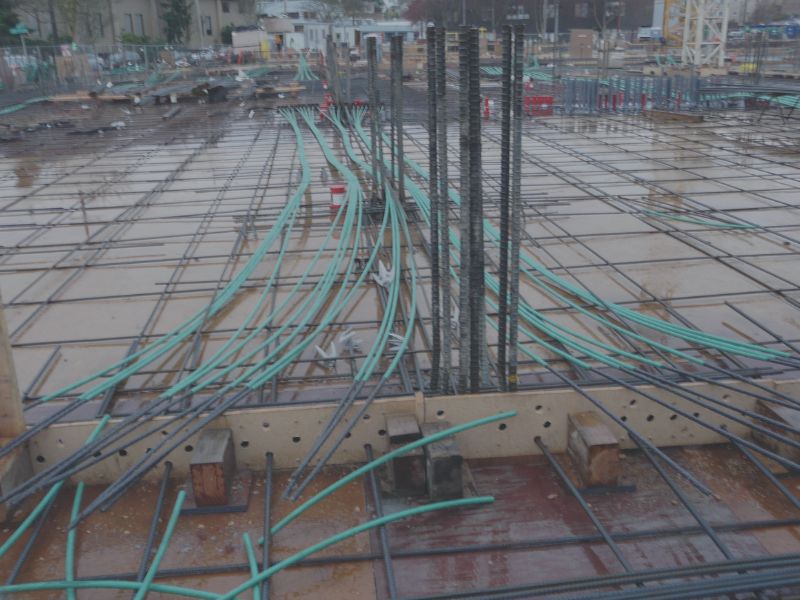Builders in modern construction rely on post-tensioning systems for one clear reason – they are a game-changer when it comes to reinforcing concrete in large-scale projects. And when it comes to laying the foundation for both residential and commercial structures, post-tension slabs have emerged as a go-to method.
In this blog, we’ll delve deeper into the world of post-tension slabs, exploring their advantages and challenges.
What Are Post-Tension Slabs?
The journey of enhancing concrete’s strength began back in the 1950s. The concept of pre-stressing, now a standard in construction, involves using steel cables or tendons to compress concrete before it bears the brunt of structural loads.
As the construction industry honed its techniques, post-tensioning became the preferred method for reinforced concrete slab foundations. The Federal Housing Administration officially endorsed post-tensioned slabs in 1969, and they have since become a staple in construction.
Post-tensioned slabs feature steel cables, or tendons, crisscrossing through the center of the hardened concrete. As the concrete cures, these cables tighten, exerting significant force on the slab.
This process fortifies the concrete, reducing cracks and bolstering its structural stability, particularly in regions with unstable soil conditions such as marshes, swamps, and lake areas. Post-tension slabs provide increased load-bearing strength, making them more resilient than traditional slabs.
Why Use Post-Tension Slabs?
Concrete slabs inherently have weaknesses, vulnerable to expansion and contraction due to weather fluctuations. Just like roads suffer potholes in winter, concrete slabs are not immune. Soil expansion and contraction due to moisture changes also threaten their integrity. In regions, where unstable soils are common, laying concrete slabs can be challenging.
Builders turn to post-tension slabs to mitigate the risks of cracking, contraction, and soil-related issues, ultimately enhancing the foundation’s strength.
Post-Tension Slabs: Potential Challenges
While post-tension slabs are superior to traditional concrete slabs, they aren’t without their challenges. Let’s explore some of the common issues faced by builders using post-tensioned slabs:
1. Long-Term Planning
Post-tensioned slabs are excellent for new structures, but builders must carefully plan for drainage. Gutters, downspouts, roof pitches, and balconies all play a role in directing rainfall away from the foundation to prevent seepage that can lead to cracks.
2. Good Quality Comes at a Price
Constructing a post-tension slab demands skilled labor, quality materials, and a deep understanding of the process’s intricacies. In the construction industry, thorough research of service providers and contractors is essential to ensure the job is done right.
3. Check the Blueprints, Twice
Precision is crucial with post-tension slabs since the steel tendons must align precisely as indicated in the blueprints. Incorrect tendon placement can cause uplift, as the tendon may exert more force than the concrete’s weight, leading to physical lifting of the slab.
The Advantages of Post-Tension Slabs
Apart from delivering crack-free surfaces, post-tension slabs offer numerous benefits compared to traditional concrete slabs. Here are a few major advantages:
1. Cost Savings
Post-tensioned slabs require less concrete than traditional ones, reducing construction costs. Additionally, these slabs help homeowners avoid the expenses associated with concrete repairs due to cracking and contraction, making them a wise long-term investment.
2. Shed Some Weight
Thinner yet stronger post-tensioned slabs allow builders more creative freedom. The reduced material usage creates additional space for pillars, walls, columns, and beams, fostering innovative design possibilities.
3. Minimize Risks
While post-tensioned slabs aren’t immune to the elements, they are more durable. Cracks, if they occur, tend to remain contained and do not spread as rapidly as on traditional foundation slabs, providing enhanced structural integrity.
Conclusion
Whether you opt for a traditional concrete slab or a fortified post-tensioned one, maintaining a commercial or residential structure’s integrity is paramount. Post-tensioned slabs are getting much traction in India and people who are planning to construct a new building (residential or commercial) started checking with construction contractors about the scope of PT-slabs. Contact BlueWing DCPL for discussing your construction project with Post-Tensioned Slabs.
